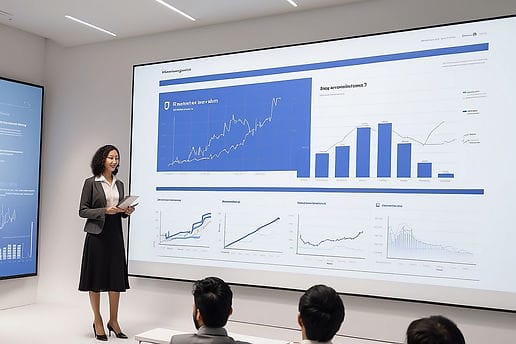From Numbers to Narratives: The Science of Data Storytelling for Small Businesses
But how do you transform cold, hard facts into warm, engaging narratives? How can you make your quarterly sales report as gripping as a page-turner novel?

In a world awash with data, the ability to tell a compelling story with numbers isn't just a nice-to-have skill—it's a superpower. For small businesses navigating the complex landscape of modern commerce, mastering the art and science of data storytelling can be the difference between drowning in spreadsheets and surfing the waves of insight to success.
But how do you transform cold, hard facts into warm, engaging narratives? How can you make your quarterly sales report as gripping as a page-turner novel? Grab your calculators and your creativity, small business owners, as we dive into the fascinating world where left brain meets right brain: the science of data storytelling.
Why Data Storytelling? The Proof is in the Pixels
Before we crunch the numbers, let's talk about why this matters. In the words of data visualisation expert Cole Nussbaumer Knaflic, "Stories are powerful because they connect us emotionally to information and provide context that allows us to understand it."
This isn't just anecdotal—it's backed by science. A study by Stanford professor Chip Heath found that 63% of participants could recall stories, but only 5% could remember a single statistic. By combining data with narrative, you're not just informing—you're persuading and inspiring action.
The Alchemy of Data Storytelling: Turning Raw Numbers into Golden Insights
So, how do you transform your data from a jumble of numbers into a compelling narrative?
Here's your formula for success:
1. Start with a Question
Every good story starts with a question or problem. In data storytelling, this is your analytical question.
Data Storytelling Tip: Frame your data exploration around a specific, relevant question. Instead of "Here's our sales data," try "How can we boost our slow summer months?"
2. Know Your Audience
Understanding who you're presenting to will shape how you tell your data story.
Data Storytelling Tip: Tailor your story to your audience's level of expertise and interests. A presentation to fellow managers might dive deeper into the numbers, while a pitch to potential investors might focus more on growth trends and market positioning.
3. Choose the Right Visuals
Different types of data require different types of visualisations. Choosing the right chart or graph can make or break your story.
Data Storytelling Tip: Use bar charts for comparisons, line graphs for trends over time, and pie charts (sparingly!) for showing composition. For more complex data, consider interactive visualisations that allow your audience to explore the data themselves.
4. Highlight the Key Message
Your data likely contains multiple insights, but focus on the most important one for your story.
Data Storytelling Tip: Use colour, size, or position to draw attention to the key data points that support your main message. Everything else should be supportive or contextual.
5. Provide Context
Numbers in isolation are meaningless. Provide context to give your data meaning.
Data Storytelling Tip: Compare your data to industry benchmarks, historical performance, or goals. A 10% growth rate might seem good, but it's even more impressive if the industry average is only 2%.
6. Create a Narrative Arc
Just like any good story, your data narrative should have a beginning, middle and end.
Data Storytelling Tip: Start by setting the scene (the business context), introduce the conflict (the challenge revealed by the data), and end with the resolution (the insight or recommended action based on the data).
The Data Storyteller's Toolkit: Essential Techniques for Small Businesses
Now that we have our formula, let's explore some specific techniques you can use to elevate your data storytelling:
1. The Power of Comparison
Humans are wired to understand things in relation to other things. Use this to your advantage.
Small Business Example: A local coffee shop could compare their foot traffic during different times of the day, week, or year, visually highlighting the periods ripe for growth strategies.
2. Personification of Data
Give your numbers a human face to make them more relatable.
Small Business Example: Instead of saying "We have a 95% customer satisfaction rate," a boutique hotel might say "95 out of 100 guests leave with a smile." You could visualise this with 100 simple face icons, 95 smiling and 5 neutral.
3. Anchoring with Analogy
Use familiar concepts to make large numbers or complex ideas more understandable.
Small Business Example: A small eco-friendly packaging company might say, "Our new process saves enough energy each month to power 50 homes for a year," instead of quoting kilowatt-hours.
4. Interactive Storytelling
Allow your audience to explore the data themselves for a more engaging experience.
Small Business Example: A local real estate agency could create an interactive map showing house prices in different neighbourhoods, allowing potential buyers to click for more details.
5. Before and After
Show the impact of a change or intervention clearly by contrasting before and after states.
Small Business Example: A personal training studio could show client progress with simple before and after visualisations of key health metrics.
The Science Behind the Story: Why These Techniques Work
These storytelling techniques aren't just creative flourishes—they're rooted in cognitive science:
- The Picture Superiority Effect: Research shows that people remember images far better than words. This is why effective data visualisation is so powerful.
- Cognitive Load Theory: Our working memory can only handle so much information at once. Good data storytelling breaks complex information into manageable chunks.
- The Von Restorff Effect: Also known as the isolation effect, this principle states that an item that stands out is more likely to be remembered. This is why highlighting key data points is so effective.
- Narrative Transportation Theory: This theory suggests that when people are absorbed in a story, their attitudes and intentions change to reflect that story. By creating a narrative around your data, you're more likely to influence your audience's thinking and decision-making.
Avoiding the Pitfalls: The Ethics of Data Storytelling
With great power comes great responsibility. As you craft your data stories, keep these ethical considerations in mind:
- Don't Manipulate Scales: Always start your axes at zero to avoid exaggerating differences.
- Provide Full Context: Don't cherry-pick data that supports your point while ignoring contradictory information.
- Respect Privacy: Ensure any personal data used in your storytelling is properly anonymized and obtained ethically.
- Acknowledge Limitations: Be upfront about the constraints or potential biases in your data.
Measuring Success: The Impact of Your Data Story
How do you know if your data storytelling is effective? Here are some metrics to consider:
- Engagement: Are people asking questions and discussing the insights presented?
- Action: Did your story lead to concrete decisions or changes?
- Retention: Can your audience recall the key points after the presentation?
- Sharing: Is your data story being passed along to others in the organisation?
The Future of Data Storytelling: Trends to Watch
As technology evolves, so does the field of data storytelling. Here are some trends small businesses should keep an eye on:
- Augmented Analytics: AI-powered tools that can automatically generate insights and narratives from data.
- Virtual and Augmented Reality: Immersive data experiences that enable new ways to interact with information.
- Real-Time Storytelling: Live data feeds that update visualisations and narratives on the fly.
- Democratisation of Data: Tools that make it easier for non-technical users to create compelling data stories.
The Moral of the Story
In the age of information, data is abundant—but insights are rare. By mastering the science of data storytelling, small businesses can turn their numbers into narratives that inform, persuade and inspire.
Remember, behind every spreadsheet is a story waiting to be told. With these techniques in your toolkit, you're well-equipped to uncover the narratives hiding in your numbers and share them in a way that resonates with your audience.
So, small business owners, it's time to embrace your inner data bard. Your numbers have a story to tell—and the world is waiting to hear it. After all, in the grand narrative of your business, data isn't just a supporting character—it's the hero waiting to be revealed.




